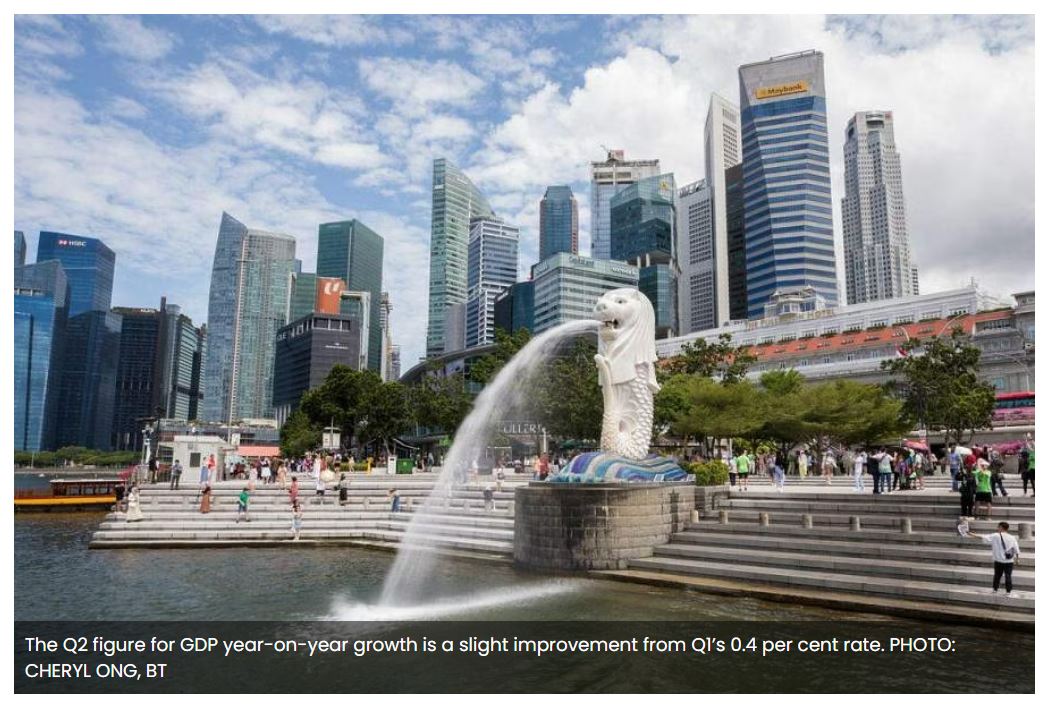Singapore narrowly avoids technical recession in Q2 as GDP grows 0.7% year on year, 0.3% quarterly
SINGAPORE’S economy grew 0.7 per cent year on year in the second quarter of 2023, dragged by a deeper downturn in the manufacturing sector, advance estimates from the Ministry of Trade and Industry (MTI) showed on Friday (Jul 14).
This was a slight improvement from Q1’s 0.4 per cent year-on-year growth.
On a seasonally adjusted quarterly basis, gross domestic product grew 0.3 per cent – reversing from the previous quarter’s 0.4 per cent fall – and helped Singapore avert a technical recession, defined as two straight quarters of quarterly contraction.
This was a better performance than what private-sector economists polled by Bloomberg were expecting – a 0.5 per cent year-on-year expansion and 0.2 per cent quarterly contraction, implying a technical recession.
The manufacturing sector shrank 7.5 per cent year on year, worsening from the previous quarter’s 5.3 per cent fall.
Output declined year on year for all manufacturing clusters, except transport engineering. Sequentially, contraction in the manufacturing sector slowed to 1.3 per cent in Q2, easing from 4.5 per cent previously.
The construction sector grew 6.6 per cent year on year, moderating from a 6.7 per cent expansion in Q1. On a quarterly basis, construction growth was 2.6 per cent, up from 0.3 per cent in Q1.
The manufacturing downturn was offset by the services industries, which grew 3 per cent year on year, up from 1.8 per cent in Q1.
The wholesale and retail trade sector and the transport and storage sector collectively expanded 2.6 per cent year on year in Q2, swinging back from a 0.7 per cent contraction in Q1. On a quarterly basis, this group grew 3.4 per cent, reversing from a 0.5 per cent fall the previous quarter.
The group of services sectors comprising information and communications, finance and insurance, and professional services grew 1.5 per cent year on year, extending the preceding quarter’s 1.3 per cent expansion. Sequentially, the group grew 1.7 per cent, a turnaround from Q1’s 1.6 per cent contraction.
Growth in information and communications was led by continued strong demand for IT and digital solutions, MTI said. However, the finance and insurance sector contracted on the back of weak performance in the insurance and banking segments.
The remaining group of services sectors expanded 6.1 per cent year on year, easing from Q1’s 7.1 per cent growth. This comprised accommodation and food services, real estate, administrative and support services and other services sectors.
On a quarterly basis, however, growth was just 0.1 per cent in Q2, slowing from the preceding quarter’s 1.9 per cent expansion.
All sectors within this group expanded, with the accommodation sector in particular registering “robust growth”, MTI said.
With year-to-date GDP growth coming in at 0.6 per cent, Barclays regional economist Brian Tan said he is again downgrading his full-year outlook to 1 per cent, from 1.5 per cent earlier.
Singapore’s official full-year forecast range is 0.5 per cent to 2.5 per cent, with “growth likely to come in at around the mid-point”.
Said Tan: “While the slump in manufacturing and regional trade activity – which could show greater signs of stabilisation in Q3 – will likely be a drag this year, we believe the recovery in services activity will continue to provide a crucial offset, as the Q2 data shows, and keep the labour market relatively tight and unemployment rates low.”
Alex Holmes, senior Asia economist at Oxford Economics, believes manufacturing’s malaise is “unlikely to turn around quickly”.
“The global electronics cycle may be nearing a trough, but it is unlikely to rebound sharply. The overall outlook for trade remains poor,” he said. “Rates in key export markets are set to remain higher for longer, meaning a bigger eventual drag from the lagged impact of monetary tightening, further tempering the growth outlook for late 2023, and 2024.”
He added that while services growth will likely remain positive, it will probably slow.
“With tourism numbers approaching pre-pandemic levels, there is less scope for more big jumps in arrivals ahead. Meanwhile, a slowing property market and precautionary savings are likely to keep Singaporean consumers in cautious mode,” said Holmes.
For growth to hit the mid-point of MTI’s forecast range, GDP growth will have to now average 1.6 per cent quarter on quarter in the second half of the year, he noted.
Source: https://www.businesstimes.com.sg/singapore/singapore-narrowly-avoids-technical-recession-q2-gdp-grows-07-year-year-03-quarterly


 Thailand
Thailand




